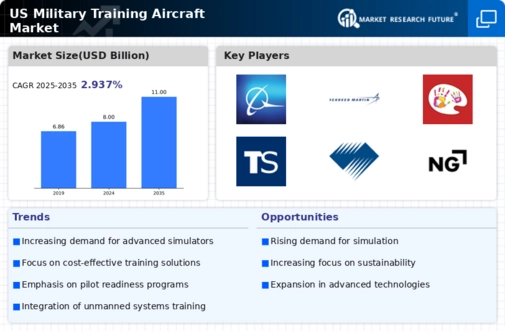Increased Defense Budgets
The military training-aircraft market is experiencing a notable boost due to increased defense budgets across various branches of the U.S. military. In recent years, the U.S. government has allocated substantial funds to enhance training capabilities, which has led to a surge in demand for advanced training aircraft. For instance, the fiscal year 2025 budget proposal indicates a projected increase of approximately 5% in defense spending, emphasizing modernization and readiness. This financial commitment is likely to drive investments in new training aircraft, ensuring that military personnel are equipped with the latest technology and skills necessary for effective operations. As a result, manufacturers in the military training-aircraft market are poised to benefit from this upward trend in defense funding, potentially leading to increased production rates and innovation in training solutions.
Partnerships with Private Sector
the military training-aircraft market is seeing partnerships between the U.S. military and private sector companies. These collaborations aim to leverage innovative technologies and expertise from the commercial aviation industry to enhance military training capabilities. Such partnerships can lead to the development of advanced training aircraft that incorporate cutting-edge technologies, improving the overall training experience for military personnel. The military training-aircraft market may benefit from these synergies, as private companies bring in new ideas and efficiencies that can reduce costs and improve training outcomes. As these collaborations continue to evolve, they are likely to play a crucial role in shaping the future of military training and aircraft development.
Growing Emphasis on Pilot Training
The military training-aircraft market is significantly influenced by the growing emphasis on pilot training within the U.S. Armed Forces. As military operations become increasingly complex, the need for highly skilled pilots has never been more critical. The U.S. Air Force has reported a shortfall of qualified pilots, prompting initiatives to enhance training programs. This situation has led to a projected increase in demand for training aircraft, with estimates suggesting a growth rate of around 6% annually in the coming years. The military training-aircraft market is thus likely to see a rise in procurement contracts aimed at addressing this pilot shortage, ensuring that training systems are robust and capable of producing proficient aviators ready for diverse operational scenarios.
Focus on Readiness and Operational Efficiency
the military training-aircraft market is driven by a heightened focus on readiness and operational efficiency within the U.S. military. As geopolitical tensions rise, the need for a well-prepared and responsive military force has become paramount. This focus translates into a demand for training aircraft that can simulate real-world combat scenarios, ensuring that pilots are adequately prepared for various missions. The military training-aircraft market is likely to see increased investments in aircraft that enhance training effectiveness and operational readiness. Additionally, the U.S. military's strategic initiatives to streamline training processes may lead to a consolidation of training platforms, further driving demand for versatile training aircraft capable of meeting diverse operational requirements.
Technological Integration in Training Programs
The integration of advanced technologies into training programs is a key driver for the military training-aircraft market. Innovations such as virtual reality (VR), augmented reality (AR), and artificial intelligence (AI) are being increasingly adopted to enhance the training experience. These technologies allow for more immersive and effective training scenarios, which are essential for preparing pilots for real-world challenges. The military training-aircraft market is likely to benefit from this trend, as defense contractors invest in developing aircraft that can support these advanced training methodologies. Furthermore, the U.S. military's commitment to modernizing its training infrastructure suggests a potential increase in funding for aircraft that incorporate these technologies, thereby driving market growth.

















Leave a Comment